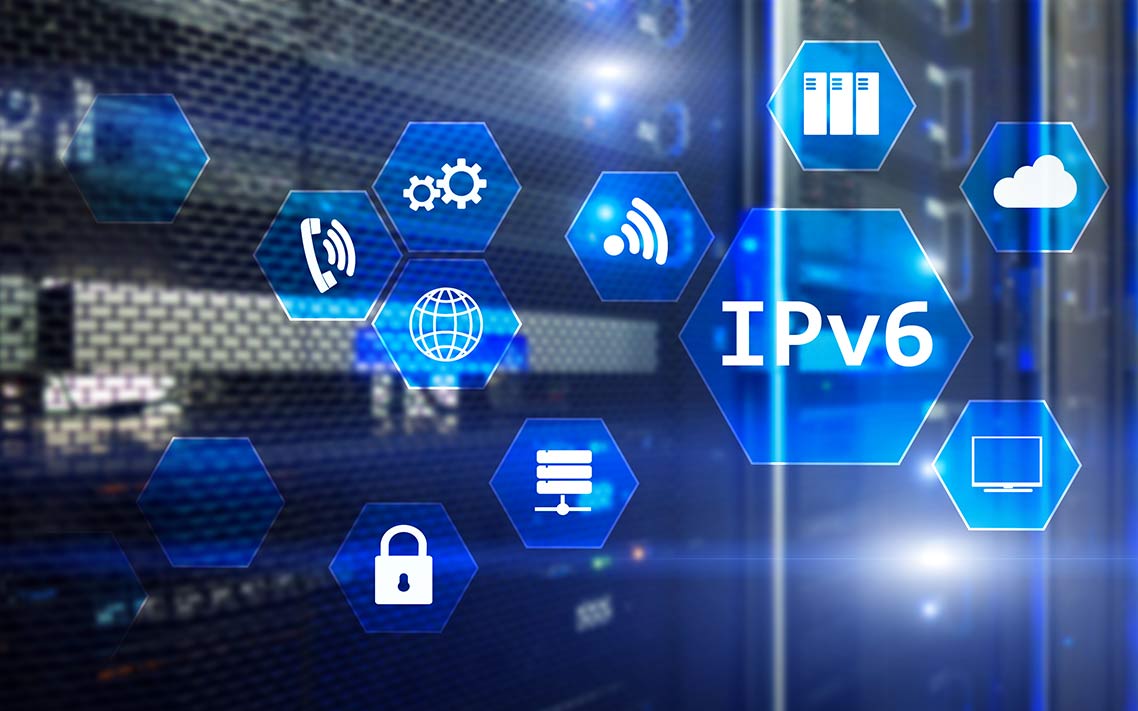
Learn the Difference Between IPv4 and IPv6
The Internet Protocol, or IP, is the set of rules that makes it possible for our computers and other communication devices to connect to each other over the internet. Whenever you open a website on your browser, a data packet with your IP address is sent to the web server’s own IP address, after which the website is then served over the internet back to your device.
IP addresses operate in the same way as street addresses laid out on a map. They direct packets to their intended destinations. IP controls all internet traffic. Data packets with the IP information of their points of origin and their destinations travel on the internet, with routers helping to direct them down the correct path.
What is TCP/IP?
IP is the other half of TCP/IP or the so-called Internet Protocol Suite. TCP, Transmission Control Protocol, governs the transport layer while IP is concerned with the network layer. TCP/IP was developed by the Defense Advanced Research Projects Agency (DARPA), a US federal agency under the Department of Defense. It became the computer networking standard for the US military in 1982. Soon after, it became the primary standard for packet-switching networks like the internet.
What are IPv4 and IPv6?
IPv4 and IPv6 stand for Internet Protocol version 4 and version 6, respectively. The two versions currently coexist, and IPv6 will take over once the IPv4 addresses run out. What are the major differences between IPv4 and IPv6? Let’s find out.
IPv4 Definition
 IPv4 is a connectionless protocol operating on a best-effort delivery model, which means it does not guarantee delivery nor can it avoid duplicates. TCP sits atop IP and addresses these shortcomings through mechanisms such as data integrity checking.
IPv4 is a connectionless protocol operating on a best-effort delivery model, which means it does not guarantee delivery nor can it avoid duplicates. TCP sits atop IP and addresses these shortcomings through mechanisms such as data integrity checking.
IPv4 became the main protocol governing data packet transmissions in 1981. During the definition of the standard, the version numbers progressed rapidly, starting with version 1 until IPv4 became the one that was utilized in ARPANET, the forerunner of the internet, in 1983.
Originally, IP addresses were designed to support only a low number of networks. By the time IPv4 was rolled out in 1981, it had been divided into address classes in a classful network addressing architecture to cope with this limitation. This architecture was superseded in 1993 when Classless Inter-Domain Routing (CIDR) was introduced to slow both IPv4 address exhaustion and the rapid growth of routing tables across the internet.
IPv4 addresses are numeric and formatted using dotted decimal notation, or four decimal octets separated by dots, e.g., 172.217.31.238. Since an octet is eight bits in length, with the four octets, each IPv4 address is 32-bits, or four bytes, long.
At 232 IP addresses, the number of IPv4 addresses total almost 4.3 billion. The number goes down to around four billion if some 300 million addresses reserved for multicast and private networks are excluded. Network address translation (NAT) is used to allow IP addresses reserved for private networks to communicate over the internet.
It was originally thought that IPv4 could provide IP addresses for all devices on the internet but it soon became apparent that a more robust alternative was needed to meet future demand, even if IPv4 addresses could be reused. With the number of devices accessing the internet already numbering in the billions, especially since smartphones and the Internet of Things (IoT) have become ubiquitous, almost all IPv4 addresses have been assigned—enter IPv6.
IPv6 Definition
As internet use took off in the 1990s, the Internet Engineering Task Force (IETF), the open standards body in charge of defining technical internet protocols, became aware of a potential problem in IPv4: The number of available IP addresses it can generate is limited and will not be enough to assign to devices accessing the internet in the foreseeable future.
The IETF decided that a better standard for future-proof IP addressing was needed. By 1998, it had come up with a draft standard for the better and improved IPv6, which was intended to supersede IPv4 eventually.
IPv6 provides for a 128-bit IP address. This means that it allows the generation of 2^128 or approximately 3.4 × 10^38 addresses. In layman’s terms, the number of IPv6 addresses can be trillions of trillions.
Since IPv6 also reserves blocks of numbers for special use or excludes some numbers from use altogether, the actual number of IPv6 addresses should be slightly less, just like in IPv4. Still, the number of IPv6 addresses is virtually limitless and should be enough to meet future demand.
While IPv6 conforms to the same design principles as IPv4, IPv6 addresses come in eight groups of four hexadecimal digits, with each separated by colons such as fe80:0000:0000:0350:9804:1781:4371:2d03. The majority of IPv6 addresses don’t occupy all their 128 bits, leading to fields that contain only zeros or gets padded with zeros.
With IPv6 addressing architecture, you can use the two-colons (::)to represent a contiguous 16-bit field of zeros. For example, you can collapse fe80:0000:0000:0350:9804:1781:4371:2d03 into fe80::0350:9804:1781:4371:2d03 to make it more readable.
IPv4 and IPv6 Differences
The most significant difference between IPv4 and IPv6 is the virtually limitless number of IP addresses allowed in the latter. When IPv4 came out, mobile devices were not yet common. Thus, IPv4 was built without mobile networks and IoT-enabled devices in mind. When these devices go online and connect to the internet, they go through indirectly, via NAT. This process can sometimes pose problems for IPv4 devices.
With mobile device internet access now the standard, shifting to IPv6 is imperative, as it allows for more streamlined communications between devices. It is not surprising that mobile networks lead in the adoption of IPv6, given the advantages it offers them. IPv6 allows a single device to have multiple IP addresses depending on how that device is used. Instead of going through NAT, each device connects directly to the internet using its own assigned IP address.
When IPv4 came out, network security was not yet anyone’s foremost concern. However, IPv4’s updates allow it to be configured with the same IP security standards as IPv6. Although IPv6 is designed to be more secure with its built-in encryption capabilities and packet integrity checking, IPv4 can also be made more secure so there is essentially no difference between them when it comes to Internet Protocol security (IPsec).
However, IPv4 requires Address Resolution Protocol (ARP) to map to a device’s physical, or media access control (MAC), address. ARP is prone to spoofing and can be a vector for man-in-the-middle or denial-of-service attacks on a network. Although this risk can be mitigated by using software designed to prevent such attacks, it nevertheless poses a problem.
To map to a device’s MAC address, IPv6 uses the more robust Neighbor Discovery Protocol (NDP) and its related extensions, including Secure Neighbor Discovery Protocol (SEND), a security extension that provides cryptographic addresses and public key infrastructure (PKI) separate from the IPsec inherent in IPv6. Thus, despite IP security presence in IPv4, there remains a difference between IPv4 and IPv6, security-wise.
As for device configuration, IPv4 may either require extensive manual configuration or assisted configuration using Dynamic Host Configuration Protocol (DHCP). In contrast, autoconfiguration is available for each device with an IPv6 address. Again, IPv6 wins hands down when it comes to device configuration.
Since it has matured and improved through the years, IPv4 performs at speeds up to par with IPv6, which is theoretically faster since it does not require NAT. However, IPv6 network performance should surpass IPv4 networks soon, as network administrators become more adept in optimizing them like they have learned to tune IPv4 networks.
| Feature | IPv4 | IPv6 |
| Size of the address | 32 bits | 128 bits |
| Addressing method | IPv4 is a numeric address. It uses a dotted notation to separate the binary octets. |
IPv6 is an alphanumeric address. It uses a colon to separate the binary bits. |
| Number of classes | There are five classes, A to E. | It allows a limitless number of IP addresses. |
| Type of addresses | Unicast, multicast, broadcast | Unicast, multicast, and anycast |
| Number of header fields | 12 | 8 |
| Length of header filed | 20 | 40 |
| Checksum fields | Has checksum fields | Has no checksum fields |
| Packet size | The minimum packet size for an IPv4 is 576 bytes. | The minimum packet size for an IPv4 is 1208 bytes. |
| Mapping | IPv4 uses the address resolution protocol (ARP) to map an IP address to the media access control (MAC) address. |
IPv6 uses the neighbor discovery protocol (NDP) to map the IP to MAC address. |
| Dynamic host configuration server (DHCS) | Clients request the DHCSs’ for IP addresses before connecting to the network. |
Clients have permanent addresses. There is no need for DHCSs. |
| Simple network management protocol (SNMP) | IPv4 uses SNMP for system management. | IPv6 does not use SNMP |
| Compatibility with mobile devices | IPv4 uses a dot-decimal notation, which is not appropriate for mobile networks. |
IPv6 uses hexadecimal colon-separated notation, which is more appropriate for mobile networks. |
| Local subnet group management | IPv4 uses the internet group management protocol (GMP) | IPv6 uses multicast listener discovery (MLD). |
| Interoperability and mobility | It limits network topologies, therefore, hindering interoperability and mobility. |
It has interoperability and mobility capabilities embedded in network devices. |
| Subnet mask | The designated network uses the subnet mask from the host portion. |
It does not use subnet masks. |
| Routing information protocol (RIP) | IPv4 supports RIP | IPv6 does not support RIP |
| Address features | IPv4 uses the network address translation (NAT) that allows a single address to mask multiple non-routable addresses. |
IPv6 uses direct addressing due to its vast address space. |
| Security | Security depends on the applications. | IPv6 has an internet protocol security (IPsec) built into the protocol to provide automatic security. |
| Optional fields | Has optional fields | It has no optional fields. It offers extension headers. |
IPv6 Pros and Cons
The danger of eventually running out of IP addresses has passed because of IPv6. However, the larger number of addresses in IPv6 is not the only advantage it has over IPv4.
Pros
Hierarchical address allocation
For one, hierarchical address allocation in IPv6 addresses the increasingly complex routing tables in IPv4, an issue that had been addressed previously through CIDR. IPv6 addressing is straightforward and does not pose a problem for routers. With IPv6, CIDR is no longer essential, though you can still use it for router configuration.
New packet format
Moreover, IPv6 has a new packet format that is designed to undergo minimal router processing. Thus, IPv6 should make for easier network management, more efficient routing, and better device mobility. However, since the packet format for IPv6 is different from that of IPv4, the two IP standards are not interoperable. The IETF has tried to mitigate the potential issues arising from this non-interoperability; so far, these measures have proven successful in ensuring that both standards can operate together without any major issues.
Multicast addressing
Another area where IPv6 holds an edge is multicast addressing, which allows devices to send bandwidth-intensive packets such as multimedia streams to multiple destinations simultaneously.
Easier Configuration
IPv6 also provides for easier configuration. It allows simultaneous connections to multiple networks, which is not possible with IPv4. While IPv6 can still use static IP addresses or DHCP, it can utilize stateless automatic configuration. This allows seamless integration with prefixes and routers on the network and at the same time gives IPv6 devices the capability to assign addresses automatically to themselves using a unique 64-bit identifier. This auto-configuration capability is why IPv6 is ideal for use in IoT-enabled devices.
Better Security
Other benefits of IPv6 include better security out of the box. With IPv6, ping scans are no longer needed, taking away a potential vector for worms to spread across your network. On the minus side, this leaves DNS servers as potential targets for attackers.
Cons
Upgrade networking devices
Other cons of IPv6 include the need to upgrade networking devices that are not designed for IPv6.
Overly long IPv6 addresses
It may also prove difficult to type and remember overly long IPv6 addresses composed of letters and numbers and fit them in network topology diagrams. Although this sounds trivial, it may prove to be difficult and bothersome if you are administering large networks. You also must remember to enable IPv6 routing and disable IPv4 routing at the same time when you start moving to IPv6.
Migration
Migration from IPv4 to IPv6 may prove complicated, given that the two protocols are not backward compatible. This may mean assigning new IP addresses manually at the start. This process should become less problematic as networks eventually transition to IPv6.
To minimize costs when moving to IPv6, companies can adopt a strategy that would allow them to leverage their current IPv4 infrastructure while taking advantage of the benefits offered by IPv6. Instead of totally replacing IPv4 with IPv6, you can opt to have a dual-stack network where your hardware runs on both protocols, using IPv6 when possible. This approach is feasible since it is supported by major vendors.
IPv6 Adoption Trend
While IPv4 and IPv6 coexist right now, they are not designed to be interoperable. The IETF has several strategies in place to ensure that both protocols can exist together while preparing for the transition to IPv6. These allow IPv4 and IPv6 hosts to communicate with each other. Eventually, IPv6 addresses will become the norm, but that may still take a few more years.
The number of ISPs and mobile carriers willing to migrate to IPv6, as well as large organizations, cloud providers, and data centers, and how they will migrate their data, will determine how IPv6 will be used in the future. On parallel networks, IPv4 and IPv6 can coexist. As a result, there are no strong incentives for institutions such as ISPs to explore IPv6 choices over IPv4, especially since upgrading takes a large amount of time and money.
Despite the cost, the digital world is gradually migrating away from the inefficient IPv4 model and toward the more efficient IPv6 model. IPv6’s long-term benefits.
While the anticipated total shift to IPv6 has yet to occur, internet registries around the world are already running out of IPv4 addresses. The biggest factor behind the slow adoption of IPv6 is the NAT, which allows the relatively narrow range of private IPv4 addresses to be used over the public internet. With NAT providing a workaround for the limited number of IPv4 addresses, corporate networks have not moved hastily towards IPv6.
The transition towards IPv6 has been slow. Although the deployment of IPv6 started in 2006, IPv6 itself only became an official internet standard in 2017.
With internet registries sounding the alarm, IPv6 is now poised to take center stage in the IP-addressing space. Although it had more than two decades to mature, it has gained widespread traction in recent years.
Mobile networks, followed closely by internet service providers (ISPs), lead adoption of IPv6. Major websites have started transitioning to IPv6 as well. Trailing at the back are enterprises, hampered by their existing investments in IPv4 networks.
Problems encountered when migrating to IPv6 make matters worse for IPv6 adoption. For example, a Windows 10 bug related to IPv6 delayed Microsoft’s efforts to transition to IPv6 at its Seattle headquarters in 2017.
IPv4 will probably linger around for a few more years, or even another decade, as IPv4 equipment is expensive to replace. That is not to say that you should not adopt IPv6. Your organization should start moving towards IPv6 adoption to avoid any major issues later.
Parallels RAS is IPv6 Compliant
Parallels® Remote Application Server (RAS) is IPv6-compliant and maintains backward compatibility with IPv4. It supports various deployment models, from on-premises to public cloud to a mix of the two and even hyperconverged deployment.
Parallels RAS allows quick creation of a virtual desktop infrastructure (VDI) with improved security and centralized desktop management capabilities. It offers support for various hypervisors and can facilitate automatic deployment of VDI desktops on-demand through custom guest virtual machine (VM) templates.
Parallels RAS supports a multi-tenant architecture through its own Tenant Broker, allowing different tenants to share Parallels Secure Client Gateways and High Availability Load Balancers while maintaining security and usage efficiency and lowering ownership costs.
Parallels RAS also provides Security Assertion Markup Language single sign-on (SAML SSO) integration, allowing centralized access to hosted resources. It even supports third-party load balancers such as Amazon Web Services Elastic Load Balancing services.
From the Parallels RAS Console, your administrators can configure a Parallels RAS farm, deploy servers, publish applications and desktops, monitor resources, manage connected devices and define security policies using a single pane of glass. These capabilities are also available on a web-based console, which can be served from any HTML5-compliant web browser. Get started with an IPv6-compliant VDI by downloading the Parallels RAS trial.
Get started with an IPv6-compliant VDI by downloading the Parallels RAS trial.

